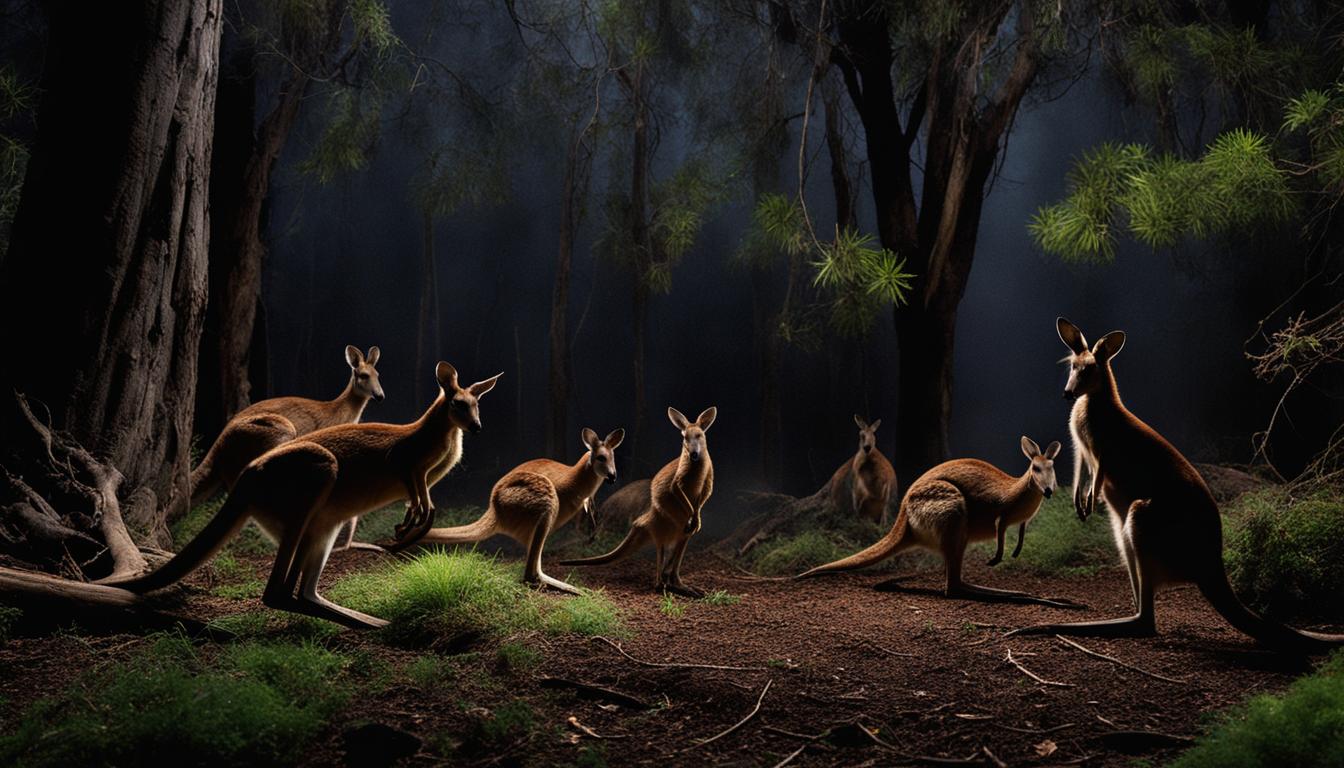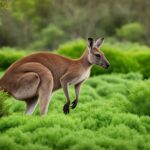Kangaroos are fascinating creatures with unique adaptations that enable them to thrive in their nocturnal lifestyle. Their behavior at night is a subject of great interest, as they exhibit specific patterns and behaviors that allow them to navigate and survive in the darkness.
When the sun sets and the night takes over, kangaroos display remarkable behavior that sets them apart from their diurnal counterparts. Their nocturnal behavior includes specific sleep patterns, feeding habits, and physical adaptations that help them excel in the dark.
Understanding kangaroo nocturnal behavior, their behavior at night, and their sleep patterns gives us a deeper appreciation for their incredible ability to adapt to their environment. Let’s explore the fascinating world of kangaroos and unravel the secrets of their nighttime adaptations.
Kangaroo Sleep Habits and Sleep Cycle During Dark Hours
Kangaroos exhibit unique sleep patterns and habits, which are closely tied to their nocturnal lifestyle. During the hottest part of the day, kangaroos prefer to sleep or rest, conserving their energy for the cooler night hours. This adaptation allows them to avoid the extreme heat and conserve water, both of which are vital for their survival in the arid Australian environment.
Female kangaroos reach sexual maturity at around 15-20 months, while males reach maturity between 20-24 months. They can breed throughout the year if the conditions are favorable. Interestingly, the gestation period for kangaroos is relatively short, as the young are born just 33 days after mating. The newborn joeys then crawl up the mother’s fur and find their way into her pouch, where they continue to develop and nurse for about a year.
Male kangaroos do not assist in raising the young and focus primarily on establishing dominance within their social hierarchy. Despite this lack of paternal involvement, kangaroos have managed to thrive and maintain a successful breeding population. In the wild, kangaroos can live up to 22 years, demonstrating their ability to adapt and survive in their unique environment.
Understanding the sleep habits and reproductive cycle of kangaroos provides valuable insights into the amazing adaptations of these iconic marsupials. These nocturnal creatures have evolved strategies to conserve energy, avoid extreme temperatures, and ensure the survival of their species. By delving deeper into the intricacies of kangaroo behavior, we gain a deeper appreciation for the remarkable ways in which animals adapt to their environments.
Table: Kangaroo Sleep Habits and Reproductive Cycle
| Sleep Habits | Reproductive Cycle |
|---|---|
| Kangaroos sleep or rest during the hottest part of the day | Female kangaroos reach sexual maturity at 15-20 months |
| They are most active during the night or early morning | Males reach sexual maturity at 20-24 months |
| Kangaroo gestation period is only 33 days | Newborn joeys crawl up the mother’s fur into her pouch |
| Female kangaroos nurse their young for about a year | Male kangaroos do not assist in raising offspring |
| The average lifespan of kangaroos in the wild is 22 years |
Kangaroo Behavior at Night and Adaptation to Low Light
Kangaroos exhibit fascinating behavior at night and have evolved specific adaptations to thrive in low light conditions. While they are generally more active during the night and periods of low light, kangaroos can also be found venturing out in bright sunlight. This irregular activity rhythm allows them to take advantage of cooler temperatures when foraging and traveling.
One interesting adaptation of kangaroos to the Australian heat is their ability to regulate their body temperature. To cool themselves, kangaroos lick their forearms, promoting heat loss through evaporation. This behavior helps them cope with the hot conditions they often encounter in their environment. They also travel and feed in groups known as mobs, allowing for increased vigilance and safety during their nocturnal activities.
Kangaroos have developed unique physical adaptations to defend themselves against predators. Their powerful hind legs enable them to deliver powerful kicks, while their strong jaws can deliver a formidable bite. Additionally, male kangaroos often engage in boxing matches to establish dominance and resolve disputes. These adaptations, combined with their nocturnal behaviors, help ensure their survival in the challenging conditions of the Australian wilderness.
The Nocturnal Behavior of Kangaroos
Kangaroos’ behavior at night is characterized by their preference for low light conditions, their ability to regulate body temperature, and their adaptation to defend themselves against predators. These behaviors and adaptations have allowed kangaroos to thrive in their unique environment and secure their place as iconic Australian animals.
| Nocturnal Behaviors of Kangaroos | Adaptations to Low Light |
|---|---|
| Irregular activity rhythm | Licking forearms to promote heat loss |
| Venturing out in bright sunlight | Traveling and feeding in groups (mobs) |
| Powerful kicks and bites for defense | Physical adaptations for self-defense |
| Boxing matches among male kangaroos |
“Kangaroos are remarkable creatures, capable of adapting to the challenges of their nocturnal lifestyle. Their behavior at night reflects their ability to thrive in low light conditions and regulate their body temperature. By understanding their unique adaptations and behaviors, we can appreciate the incredible resilience and survival skills of these captivating animals.”
Kangaroo dietary adaptations and feeding behavior
Kangaroos have a specific diet consisting of grasses, leaves, roots, and low herbaceous plants. Their unique dietary adaptations have allowed them to thrive in their environment. Kangaroos are well-adapted to grazing at night, when the temperatures are cooler and the vegetation is more readily available. This nocturnal feeding behavior helps them conserve energy and avoid the heat of the day.
When it comes to their feeding behavior, kangaroos are selective grazers. They have evolved to efficiently extract nutrients from the plants they consume. Kangaroos have tough, flat molars that are well-suited for grinding and chewing on grass and vegetation. These molars continuously grow throughout their lifespan, from the back of the mouth to the front, replacing worn-down teeth with new sets of molars.
Kangaroos also have a mutualistic relationship with bacteria in their stomachs, which aids in the breakdown of cellulose and lignin, allowing for efficient energy extraction. This symbiotic relationship enables kangaroos to digest and extract nutrients from the tough plant material they consume. It is these unique dietary adaptations and feeding behaviors that contribute to the kangaroo’s ability to survive and thrive in its natural habitat.
| Food | Description |
|---|---|
| Grasses | Kangaroos primarily feed on different types of grasses. Grass provides them with the necessary fiber and nutrients. |
| Leaves | Kangaroos also consume leaves from various shrubs and trees. Leaves provide additional nutrition and moisture. |
| Roots | Roots are an important part of their diet, especially during periods of drought when other food sources may be scarce. |
| Low herbaceous plants | Kangaroos feed on a variety of low-growing herbaceous plants, which provide them with a diverse range of nutrients. |
Overall, kangaroos have evolved specific adaptations to cope with their diet and feeding behavior. Their unique dental structure, continuous tooth growth, and symbiotic relationship with bacteria in their stomachs enable them to efficiently extract nutrients from their plant-based diet. These adaptations, coupled with their selective grazing behavior, contribute to the kangaroo’s remarkable ability to survive and thrive in the harsh Australian environment.

Kangaroo Adaptations to the Australian Heat and Arid Conditions
Kangaroos have evolved remarkable adaptations that allow them to survive in the hot and arid conditions of the Australian savannah. These adaptations enable them to conserve water and cope with the challenges of their environment.
Water Conservation
Kangaroos have developed unique strategies to conserve water. They are able to go without drinking for an impressive two days by relying on the moisture from the plants they consume. This adaptation helps them survive in the arid conditions where water sources may be scarce. Additionally, kangaroos have high urine concentration and possess a specialized kidney structure, known as the loop of Henle, which allows for the reabsorption of water. These adaptations enable them to extract and conserve as much water as possible from their limited water intake.
Estivation
During periods of extreme heat, kangaroos practice a survival strategy known as estivation. Estivation involves sealing up their pores and reducing their metabolism to conserve both energy and water. By slowing down their bodily functions, kangaroos can endure the blistering heat and reduce their water loss. This remarkable adaptation is an essential part of their ability to survive in the harsh Australian climate.
Dry Feces
Another interesting adaptation of kangaroos is their production of dry feces. Kangaroos efficiently extract water from the food they consume before it leaves their bodies, resulting in dry feces. This adaptation minimizes water loss and allows kangaroos to conserve water, contributing to their overall water conservation strategies.
| Adaptation | Description |
|---|---|
| Water Conservation | Kangaroos rely on plant moisture and have high urine concentration and specialized kidneys that enable them to conserve water. |
| Estivation | Kangaroos reduce their metabolism and seal up their pores during extreme heat to conserve energy and water. |
| Dry Feces | Kangaroos efficiently extract water from their food, resulting in dry feces and minimizing water loss. |
These adaptations enable kangaroos to thrive in the arid conditions of the Australian savannah, where water sources are limited, and temperatures can be extreme. By conserving water and minimizing water loss, kangaroos have evolved to meet the challenges of their environment.
Kangaroo Physical Adaptations for Hopping and Locomotion
Kangaroos have evolved unique physical adaptations that enable their distinctive hopping locomotion. These adaptations contribute to their remarkable ability to traverse long distances efficiently and effectively. Central to kangaroo locomotion are their powerful hind legs, which provide the force necessary for hopping. The thick bones in their legs, combined with elastic tendons and ligaments, act like a spring, storing and releasing energy with each hop. This allows kangaroos to propel themselves forward and upward, covering impressive distances with minimal effort.
In addition to their hind legs, kangaroos also possess a large tail that plays a crucial role in their balance while hopping. The tail acts as a counterbalance, allowing kangaroos to maintain stability while in mid-air. This is especially important considering the speed and height at which they hop. By using their tail as a fifth limb, kangaroos are able to execute precise and controlled movements, enabling them to navigate their environment with ease.
It is important to note that kangaroos do not hop exclusively. They are also capable of walking and bounding at lower speeds. This flexibility in locomotion allows them to adapt to different terrains and environments. However, hopping remains the most energy-efficient mode of transportation for kangaroos, making it their preferred method of movement.
Conclusion
Kangaroos are fascinating creatures that have adapted remarkably well to their nocturnal lifestyle and the challenges of their environment. They have specific adaptations for temperature regulation, feeding behavior, water conservation, and locomotion, all of which contribute to their survival and success. Understanding their nocturnal behavior and unique adaptations allows us to appreciate the remarkable nature of these captivating animals.
FAQ
How do kangaroos adapt to life in the night?
Kangaroos have several adaptations that allow them to thrive in their nocturnal lifestyle. They are most active during the night or early morning when it is cooler, and they spend the hottest part of the day sleeping or resting.
What are kangaroo sleep habits and their sleep cycle during dark hours?
Kangaroos have an irregular activity rhythm and are generally active at night and during periods of low light. However, they can also be found out in the open in bright sunlight. They sleep or rest during the hottest parts of the day.
How do kangaroos behave at night and adapt to low light?
Kangaroos can be active at night and in periods of low light. They have adapted to the dark conditions by developing enhanced night vision and other sensory adaptations to navigate and find food.
What is the dietary adaptation and feeding behavior of kangaroos?
Kangaroos have a specific diet consisting of grasses, leaves, roots, and low herbaceous plants. They feed on these plants in the wild and consume hay, grain, vegetables, and supplements in captivity. They are grazers and feed predominantly during the night.
What are kangaroo adaptations to the Australian heat and arid conditions?
Kangaroos have evolved several adaptations to survive in hot and arid conditions. They conserve water by only drinking every two days and rely on moisture from the plants they eat. They also estivate during extreme heat, reducing their metabolism to conserve energy and water.
What are the physical adaptations of kangaroos for hopping and locomotion?
Kangaroos have strong hind legs, a large tail, and elastic tendons and ligaments that act like a trampoline, enabling them to hop efficiently. Their hopping ability allows them to clear impressive distances with a single bound, reaching speeds of up to 35 miles per hour.
How do kangaroos adapt to their environment?
Kangaroos have unique adaptations for temperature regulation, feeding behavior, water conservation, and locomotion, all of which contribute to their survival and success in their environment.











